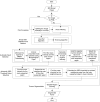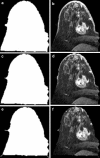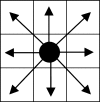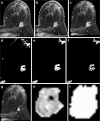Computer-aided segmentation system for breast MRI tumour using modified automatic seeded region growing (BMRI-MASRG)
- PMID: 24100762
- PMCID: PMC3903976
- DOI: 10.1007/s10278-013-9640-5
Computer-aided segmentation system for breast MRI tumour using modified automatic seeded region growing (BMRI-MASRG)
Abstract
In this paper, an automatic computer-aided detection system for breast magnetic resonance imaging (MRI) tumour segmentation will be presented. The study is focused on tumour segmentation using the modified automatic seeded region growing algorithm with a variation of the automated initial seed and threshold selection methodologies. Prior to that, some pre-processing methodologies are involved. Breast skin is detected and deleted using the integration of two algorithms, namely the level set active contour and morphological thinning. The system is applied and tested on 40 test images from the RIDER breast MRI dataset, the results are evaluated and presented in comparison to the ground truths of the dataset. The analysis of variance (ANOVA) test shows that there is a statistically significance in the performance compared to the previous segmentation approaches that have been tested on the same dataset where ANOVA p values for the evaluation measures' results are less than 0.05, such as: relative overlap (p = 0.0002), misclassification rate (p = 0.045), true negative fraction (p = 0.0001) and sum of true volume fraction (p = 0.0001).
Figures








References
-
- Gardiner I: CAD improves breast MRI workflow: increasing throughput while maintaining accuracy in breast MRI reads requires powerful workflow tools, 2010
-
- Ibrahim S, Khalid NEA, Manaf M. Empirical study of brain segmentation using particle swarm optimization. Selangor: Shah Alam; 2010.
MeSH terms
LinkOut - more resources
Full Text Sources
Other Literature Sources
Medical

